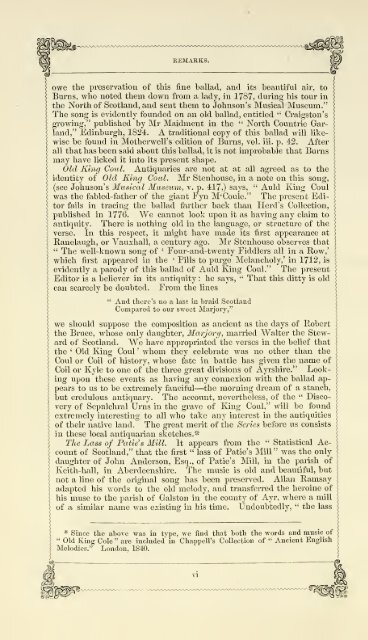[A composite volume : containing The ballads and songs of Ayrshire ...
[A composite volume : containing The ballads and songs of Ayrshire ...
[A composite volume : containing The ballads and songs of Ayrshire ...
Create successful ePaper yourself
Turn your PDF publications into a flip-book with our unique Google optimized e-Paper software.
owe the preservation <strong>of</strong> this fine ballad, <strong>and</strong> its beautiful air, to<br />
Burns, who noted them down from a lady, in 1787, during his tour in<br />
the North <strong>of</strong> Scotl<strong>and</strong>, <strong>and</strong> sent them to Johnson's Musical Museum."<br />
<strong>The</strong> song is evidently founded on an old ballad, entitled " Craigston's<br />
growing," published by Mr Maidment in the " North Countrie Garl<strong>and</strong>,"<br />
Edinburgh, 1824. A traditional copy <strong>of</strong> this ballad will likewise<br />
be found in Motherwell's edition <strong>of</strong> Bums, vol. iii. p. 42. After<br />
all that has been said about this ballad, it is not improbable that Burns<br />
may have licked it into its present shape.<br />
Old King Cotd. Antiquaries are not at at all agreed as to the<br />
identity <strong>of</strong> Old King Coul. Mr Stenhouse, in a note on this song,<br />
(see Johnson's Musical Museum, v. p. 417,) says, " Auld King Coul<br />
was the fabled-father <strong>of</strong> the giant Fyn M'Coule." <strong>The</strong> present Editor<br />
fciils in tracing the ballad farther back than Herd's Collection,<br />
published in 1776. We cannot look upon it as having any claim to \<br />
antiquity. <strong>The</strong>re is nothing old in the language, or structure <strong>of</strong> the<br />
verse. In this respect, it might have made its first appearance at<br />
Ranelaugh, or Vauxhall, a century ago. Mr Stenhouse observes that<br />
" <strong>The</strong> well-known song <strong>of</strong> Four-<strong>and</strong>-twenty Fiddlers ' all in a Row,'<br />
which first appeared in the Pills to purge Melancholy,' ' in 1712, is<br />
evidently a parody <strong>of</strong> this ballad <strong>of</strong> Auld King Coul." <strong>The</strong> present<br />
Editor is a believer in its antiquity : he says, " That this ditty is old<br />
can scarcely be doubted. From the lines<br />
" And there's no a lass in braid Scotl<strong>and</strong><br />
Compared to our sweet Marjory,"<br />
we should suppose the composition as ancient as the days <strong>of</strong> Robert<br />
the Bruce, whose only daughter, Marjory, married Walter the Steward<br />
<strong>of</strong> Scotl<strong>and</strong>. We have appropriated the verses in the belief that<br />
the Old King Coul ' ' whom they celebrate was no other than the<br />
Coul or Coil <strong>of</strong> histoiy, whose fate in battle has given the name <strong>of</strong><br />
Coil or Kyle to one <strong>of</strong> the three great divisions <strong>of</strong> <strong>Ayrshire</strong>." Looking<br />
upon these events as having any connexion with the ballad appeal's<br />
to us to be extremely fanciful—^the morning dream <strong>of</strong> a stanch,<br />
but credulous antiquary. <strong>The</strong> account, nevertheless, <strong>of</strong> the " Discovery<br />
<strong>of</strong> Sepulchral Urns in the grave <strong>of</strong> King Coul," will be found<br />
extremely interesting to all who take any interest in the antiquities<br />
<strong>of</strong> their native l<strong>and</strong>. <strong>The</strong> great merit <strong>of</strong> the Series before us consists<br />
in these local antiquarian sketches.*<br />
<strong>The</strong> Lass <strong>of</strong> Patie's Mill. It appears from the " Statistical Account<br />
<strong>of</strong> Scotl<strong>and</strong>," that the first " lass <strong>of</strong> Patie's Mill " was the only<br />
i daughter <strong>of</strong> John Anderson, Esq., <strong>of</strong> Patie's Mill, in the parish <strong>of</strong><br />
\ Keith-hall, in Aberdeenshire. <strong>The</strong> music is old <strong>and</strong> beautiful, but<br />
not a line <strong>of</strong> the original song has been preserved. Allan Ramsay<br />
adapted his words to the old melody, <strong>and</strong> transferred the heroine <strong>of</strong><br />
his muse to the parish <strong>of</strong> Galston in the county <strong>of</strong> Ayr, where a mill<br />
I<br />
<strong>of</strong> a similar name was existing in his time. Undoubtedly, " the lass<br />
* Since the above was in type, we find that both the words <strong>and</strong> music <strong>of</strong><br />
" Old King Cole " are included" in ChappeU's Collection <strong>of</strong> " Ancient English<br />
Melodies." London, 1840.

















